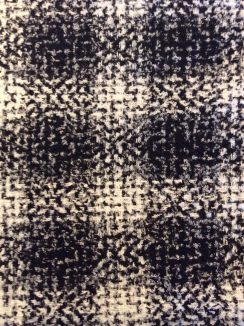[*Little Black Jacket sometimes referred to as the LFJ or Little French Jacket]

There is nothing quite like setting in the sleeves to make a jacket look like – well, a jacket! Sleeves are interesting, aren’t they? I was browsing some vintage patterns online the other day (like you do), and stumbled upon a pattern from the 1930’s that was nothing but sleeves. I thought, what a great idea! Well, it’s part of a great idea. You have to have a garment body that suits them!There is little doubt that the same body with different sleeves can look vastly different. Even the pattern I’m using for my homage to Chanel’s Little Black (French) Jacket has two sleeve variations.
I’ve chosen to make it with the two-piece, bracelet-length sleeves for this time around (I’m already considering the next one!).
Even Chanel herself gave a lot of thought to her sleeves. In the past when I’ve put sleeves in jacket-like garments, they have always tended to be a single pattern piece. If you think about it, this kind of construction doesn’t give much leeway for what our arms are really like – that is, they bend. A real Chanel jacket always has at least a two-piece sleeve and usually a three- piece one which allows for having some ease in one of the seams at the precise place where our elbows bend. In addition, the multi-piece sleeve permits the sleeve to be narrower which gives it a more polished, well-fitting, custom look.
Another of Chanel’s concerns about sleeves was that they have a relatively high armhole. This vintage photo of Chanel herself shows her holding up her arm to demonstrate that a higher armhole allows the jacket to remain in place when the wearer raises her arms. What a great idea.

Anyway, all of this research leads me back to the challenge of the day: preparing and setting in the sleeves on my own jacket.
I have already joined each sleeve’s two pieces ensuring that the requisite ease has been included. I have also machine-quilted the lining to each of the pieces. Now I am ready to construct them.
I pin back the lining along the seam just as I did when constructing the jacket body so that it doesn’t get caught up. Then, using a 3.0 mm stitch length and my trusty walking foot (could not live without it) as always with this bouclé, and remembering that I’m using a 1-inch seam allowance, I sew the seam. Then I add the two rows of ease stitching (5.0 mm stitches) over the top of the sleeve head.

I begin pressing the seam by pressing it flat first, then using a seam roll (or in my case a rolled up towel since I’ve been too cheap to buy an actual seam roll), I steam the seam allowances open with the tip of my iron. Then I steam it lightly from the right side to finish the pressing. I trim the seam allowances then it’s time to deal with the lining.
Using the same technique I used with the body of the jacket, I first secure the one-and-a-half-inch hem with a catch stitch, then use a lapped seam for the lining along the seam and fold under a half-inch above the hem. Then I use that ladder stitch to hand sew the lining in place. Now I’m ready to shape the shoulder.

I use my tailor’s ham (fortunately I wasn’t too cheap to buy a real tailor’s ham which in my opinion is an essential sewing item) as a stand-in for a shoulder, I ease in the shoulder shape. It’s now ready to be set in. I am sewing the fabric (without the lining) of the sleeves to the fabric AND the lining of the body (I basted the lining to the jacket body fabric at the armholes ages ago in the process). Many people simply pin-baste the sleeves. I am going to do what I always do with set-in sleeves – I thread baste it in. This is a challenging situation since there is so much fraying fabric and open lining pieces that will eventually have to be hand-stitched into place, not to mention a plaid that has to be matched that I do not want to take a chance on losing pins or having the sleeve shift while I’m sewing. So, working inside what is akin to a paper bag, I slowly sew the armhole seam. When I finish, I hold my breath for a moment as I turn it right-side out. The sleeve is beautiful without a pucker in sight and even more fantastic is that the plaid is perfectly matched. The I have to do it all again on the other side!
Finally, they are in and my jacket looks like it is a real jacket. I just have to trim the seams and then hand sew the sleeve lining to the body lining. They are finished and I am delighted.
I try it on with a bit of trepidation. I altered the shoulder length a bit at the muslin stage and now this is the moment of truth as regards the shoulder fit. There is nothing worse than a jacket that droops over the shoulders when it is designed to be perfectly set at the shoulder line. I adjust things and look in the mirror. Perfect. Well, perfect enough.
I’m getting close to the end of the project although there are still many hours of hand sewing ahead. I first have to consider pockets and trim, but that’s the next step.
































You must be logged in to post a comment.